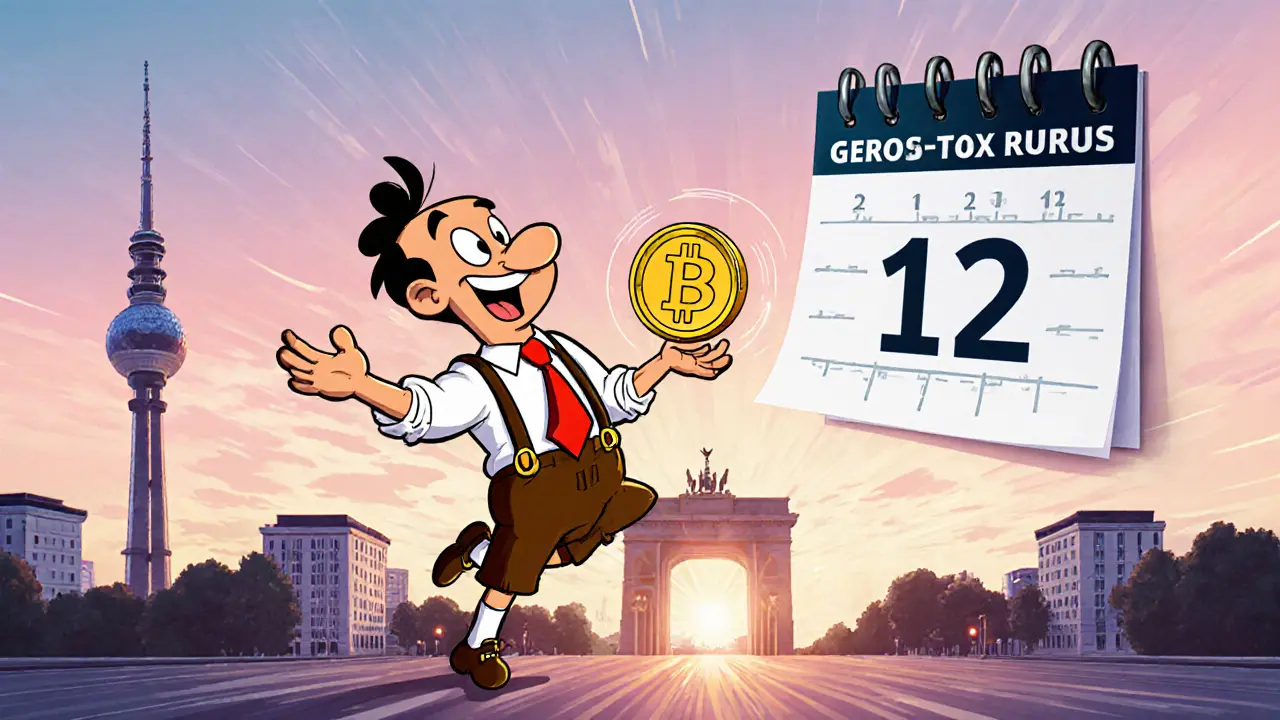
Germany Crypto Tax Calculator
Tax Calculation Parameters
Your Tax Result
Enter values and click "Calculate Tax Liability" to see your tax result.
Important Tax Information
- Rule Long-Term Holding: Assets held for 365+ days are tax-free
- Rule Short-Term Gains: Taxed at your marginal income rate (up to 47.375%)
- Allowance Annual Exemption: €1,000 tax-free for short-term profits
- Requirement Documentation: Keep records of purchase timestamps to the minute
Ever wondered why German crypto investors can sell big piles of Bitcoin or NFTs after a year and pay nothing to the tax office? The answer lies in a surprisingly simple rule that treats digital assets like a long‑term store of value. In this guide we break down how the zero tax crypto Germany rule works, what you need to track, and how it stacks up against the rest of Europe.
Key Takeaways
- Holding any cryptocurrency for 12 months or more triggers a full tax exemption on capital gains.
- Short‑term gains (under one year) are taxed at your personal income‑tax rate, up to 47.375% including the solidarity surcharge.
- You still get a €1,000 annual tax‑free allowance for short‑term profits.
- Accurate record‑keeping is crucial - the holding period is calculated to the minute.
- Compliance tools like Blockpit, Koinly, or CoinTracker can cut setup time to a few hours.
What the Law Actually Says
Germany regulates crypto under Section 23EStG, part of the Einkommensteuergesetz (Income Tax Act). The law classifies cryptocurrencies as private assets (private Veräußerungsgeschäfte) rather than securities. This matters because private assets trigger a special holding‑period rule: if you keep the asset for at least 365 days, any gain on disposal is tax‑free.
The rule applies to every digital token - Bitcoin, Ethereum, stablecoins, and even non‑fungible tokens (NFTs). The one‑year clock starts the exact minute you acquire the asset, whether you bought it on an exchange, received it as a gift, or mined it.
How the One‑Year Holding Period Is Calculated
- Record the transaction timestamp (date+time) for every purchase.
- When you sell, swap, or spend a token, match the disposal to the earliest purchase that satisfies the 12‑month rule.
- If you used a dollar‑cost averaging strategy, you may need to split the disposal across multiple acquisition dates.
- Maintain the original transaction hash, wallet address, and price in euros at the moment of purchase.
Because the tax office can request minute‑level proof, most investors rely on crypto‑tax software to auto‑match inputs and outputs. The software pulls data from exchanges via API, timestamps every trade, and generates a holding‑period report that passes a Bundeszentralamt für Steuern audit.

Short‑Term Gains: Rates and the €1,000 Allowance
If you dispose of a token before the 12‑month mark, the profit is added to your regular taxable income. Germany’s progressive income‑tax bands range from 14% to 45%. On top of that, the Solidarity Tax (Solidaritätszuschlag) adds 5.5% of the income‑tax amount, pushing the maximum short‑term rate to 47.375%.
Good news: the tax‑free allowance for crypto was raised to €1,000 in 2024. You can realize up to €1,000 of short‑term profit each calendar year without paying tax. Anything above that amount is taxed at your marginal rate.
How Germany Stacks Up Against Other Jurisdictions
| Country | Long‑Term Tax Rate | Short‑Term Rate | Annual Exemption |
|---|---|---|---|
| Germany | 0% | Up to 47.375% (incl. solidarity tax) | €1,000 (short‑term) |
| France | 30% flat (12.8% CGT + 17.2% social) | 30% flat | €0 |
| United Kingdom | 10% or 20% (CGT bands) | 10% or 20% | £3,000 |
| Portugal | 0% (long‑term) | Varies - often taxed as regular income | €0 |
| Switzerland | Taxed as wealth (cantonal rates) | Taxed as income if trading professionally | Varies by canton |
Germany’s zero‑tax advantage is unique in the EU because it pairs a strong regulatory framework with a clear, investor‑friendly rule. The higher short‑term rates act as a deterrent to day‑trading, nudging investors toward a HODL mindset.
Practical Steps to Stay Compliant
- Gather every transaction record. Export CSV files from every exchange you used in the tax year.
- Save wallet‑export files (e.g., .json, .csv) that show incoming and outgoing transfers.
- Document the euro value at acquisition using the exchange’s spot rate at that moment.
- Use a German‑compatible tax tool (Blockpit, Koinly, CoinTracker). Most offer a "Germany" preset that automatically applies the one‑year rule.
- If you earned staking rewards or DeFi interest, treat those as separate income streams; they are taxed in the year they’re received.
- Keep the documentation for ten years - the Federal Ministry of Finance can request it during an audit.
For a typical portfolio with 200 transactions, the initial setup in Blockpit takes about 2-3hours. Professional crypto accountants charge €150‑€500, depending on complexity. The cost is usually worth it if you’ve realized gains above the short‑term exemption.

DeFi, Staking, and the Grey Areas
While the holding‑period rule is crystal clear for outright buying and selling, the tax office hasn’t issued exhaustive guidance on decentralized finance. Current practice, as advised by the Bundeszentralamt für Steuern, treats staking rewards as regular income at the time of receipt. Lending protocols that lock tokens don’t reset the 12‑month clock - the original acquisition date still applies, provided you can prove continuous ownership.
Because the guidance is still evolving, many investors choose a conservative path: report all DeFi earnings as income and keep detailed logs of every smart‑contract interaction.
Future Outlook: Will the Rule Stay?
As of 2025 there are no announced changes to Section23EStG. The EU’s new Markets in Crypto‑Assets (MiCA) regulation could create pressure for harmonisation, but Germany’s strong lobbying position suggests the one‑year exemption will survive at least until the next legislative cycle (2027‑2030). Analysts expect the rule to keep attracting both retail investors and blockchain firms to set up operations in Berlin and Frankfurt.
Quick Checklist Before Filing 2025 Taxes
- Confirm every purchase date and time.
- Separate long‑term disposals (≥12months) from short‑term ones.
- Apply the €1,000 short‑term exemption.
- Report staking and DeFi earnings as income.
- Export the final tax report from your software in CSV or PDF for the Steuer‑erklärung.
Follow this list and you’ll avoid the most common pitfalls - missed holding‑period calculations and under‑reported staking income.
Frequently Asked Questions
Do I need to pay any tax if I sell Bitcoin after 13 months?
No. Under Section23EStG, any crypto disposed of after a full year is exempt from capital‑gains tax, regardless of the profit size.
What happens if I swap Ethereum for a different token before the year is up?
The swap is treated as a taxable disposal of the original token. You must calculate any gain or loss and add it to your income, then apply the €1,000 exemption if applicable.
Are NFTs covered by the same rule?
Yes. The 2024 guidance from the BMF treats NFTs as crypto assets, so a 12‑month hold yields zero tax on any resale profit.
How strict is the “to the minute” requirement?
Very strict. The tax office can ask for the exact timestamp of the acquisition recorded on the exchange. Using API‑based tax software eliminates manual errors.
Can I claim the €1,000 exemption on multiple short‑term sales?
The €1,000 allowance is per taxpayer per year. All short‑term gains are summed, and the first €1,000 is tax‑free; any amount above that is taxed at your marginal rate.





